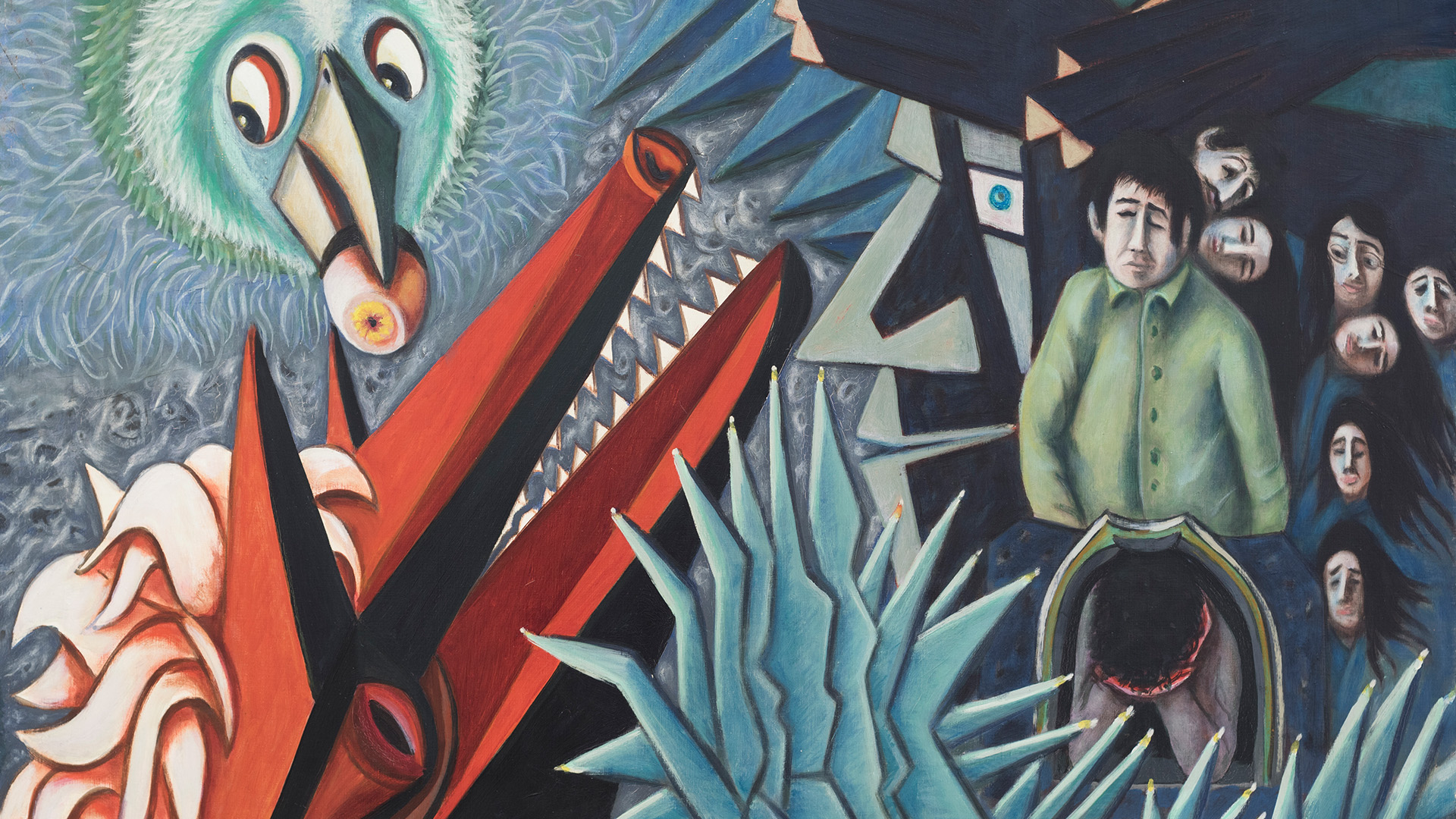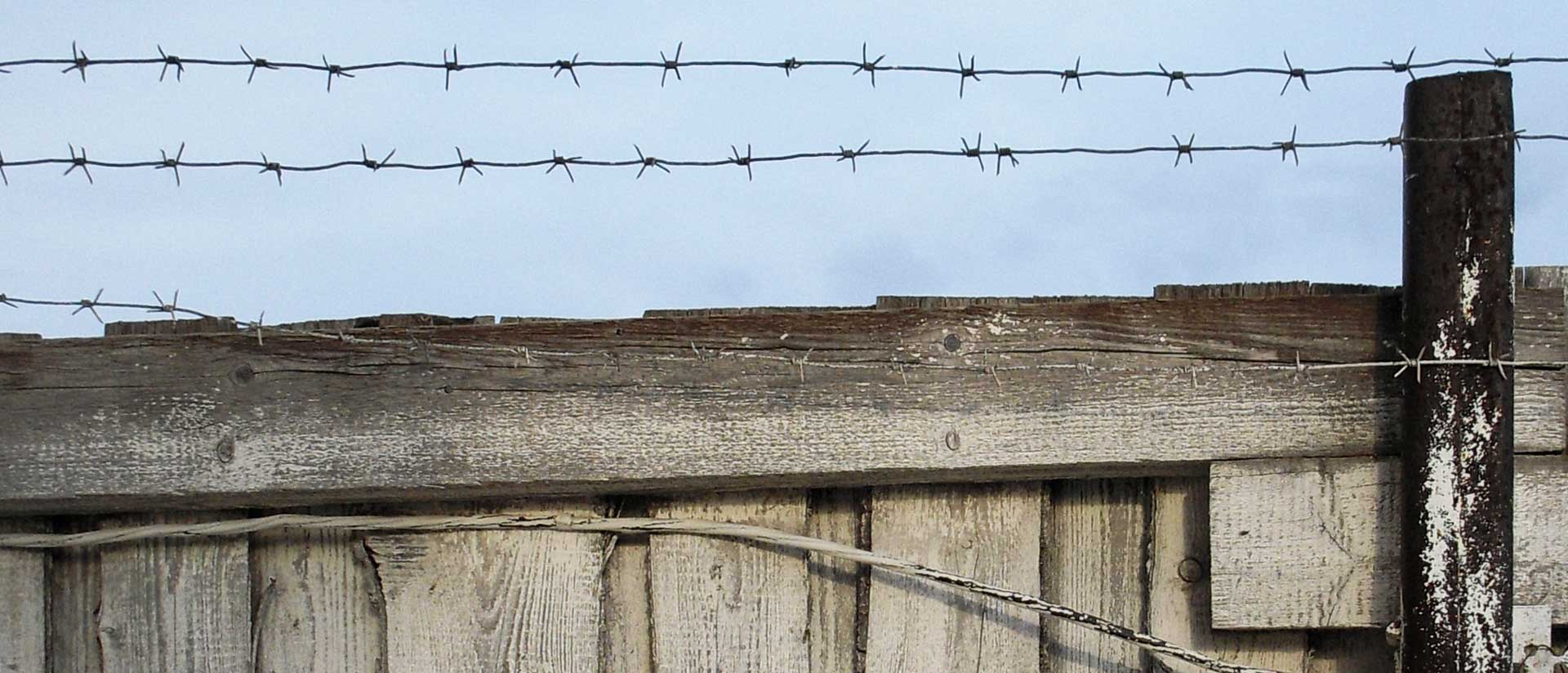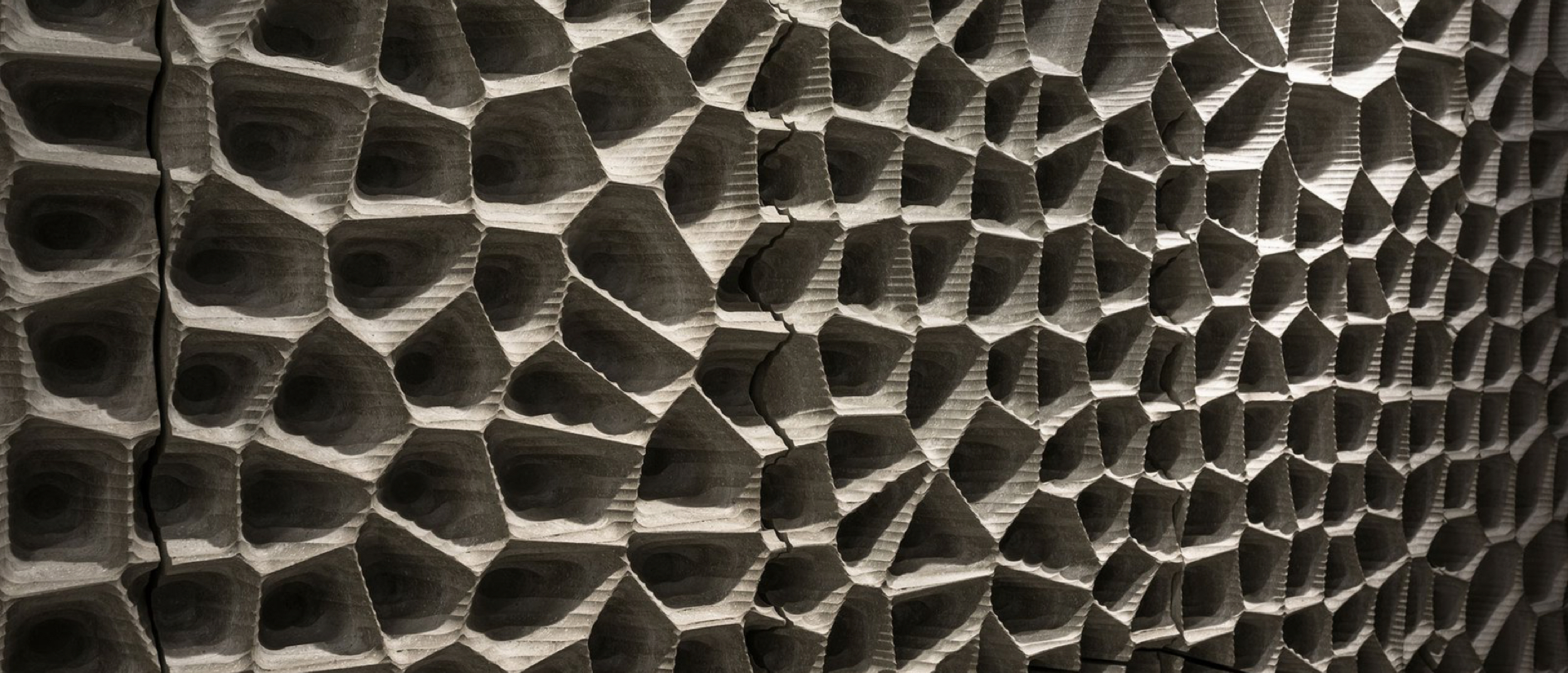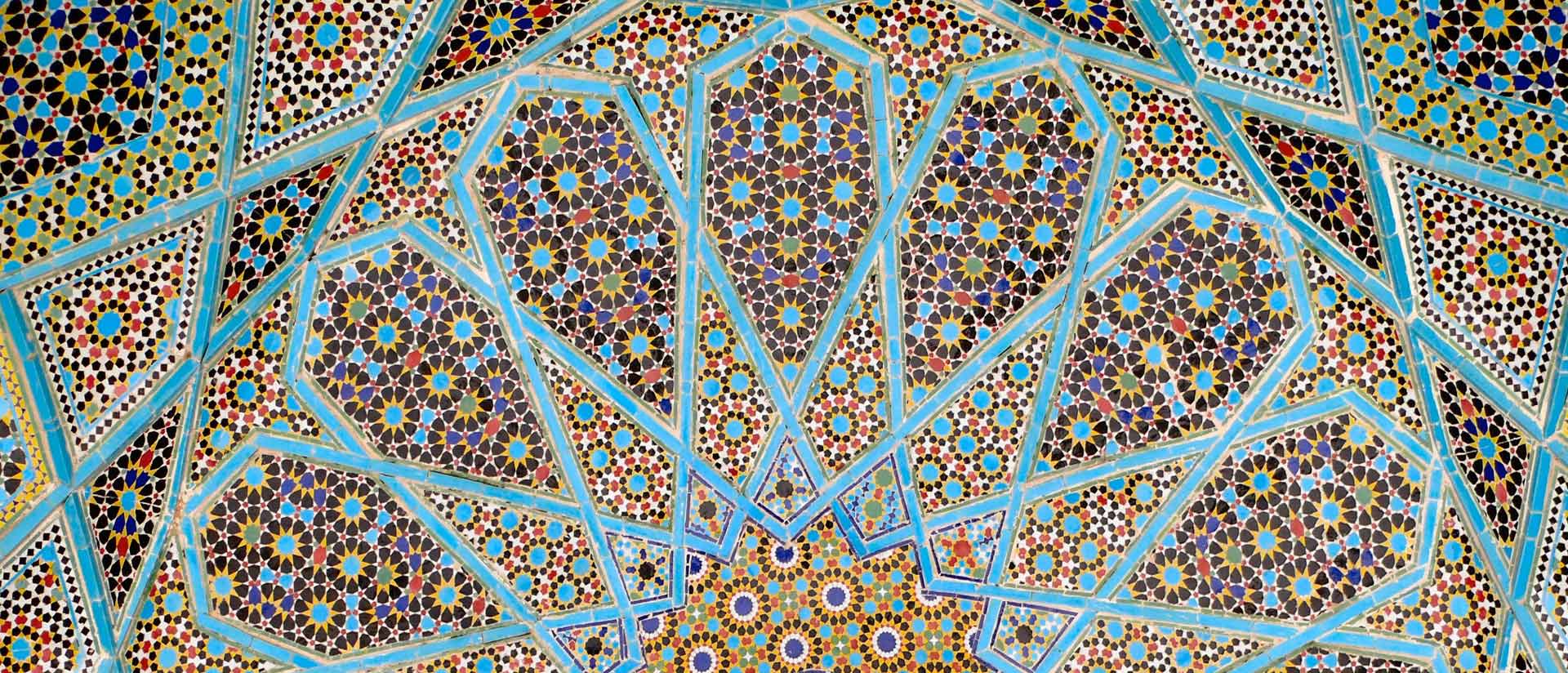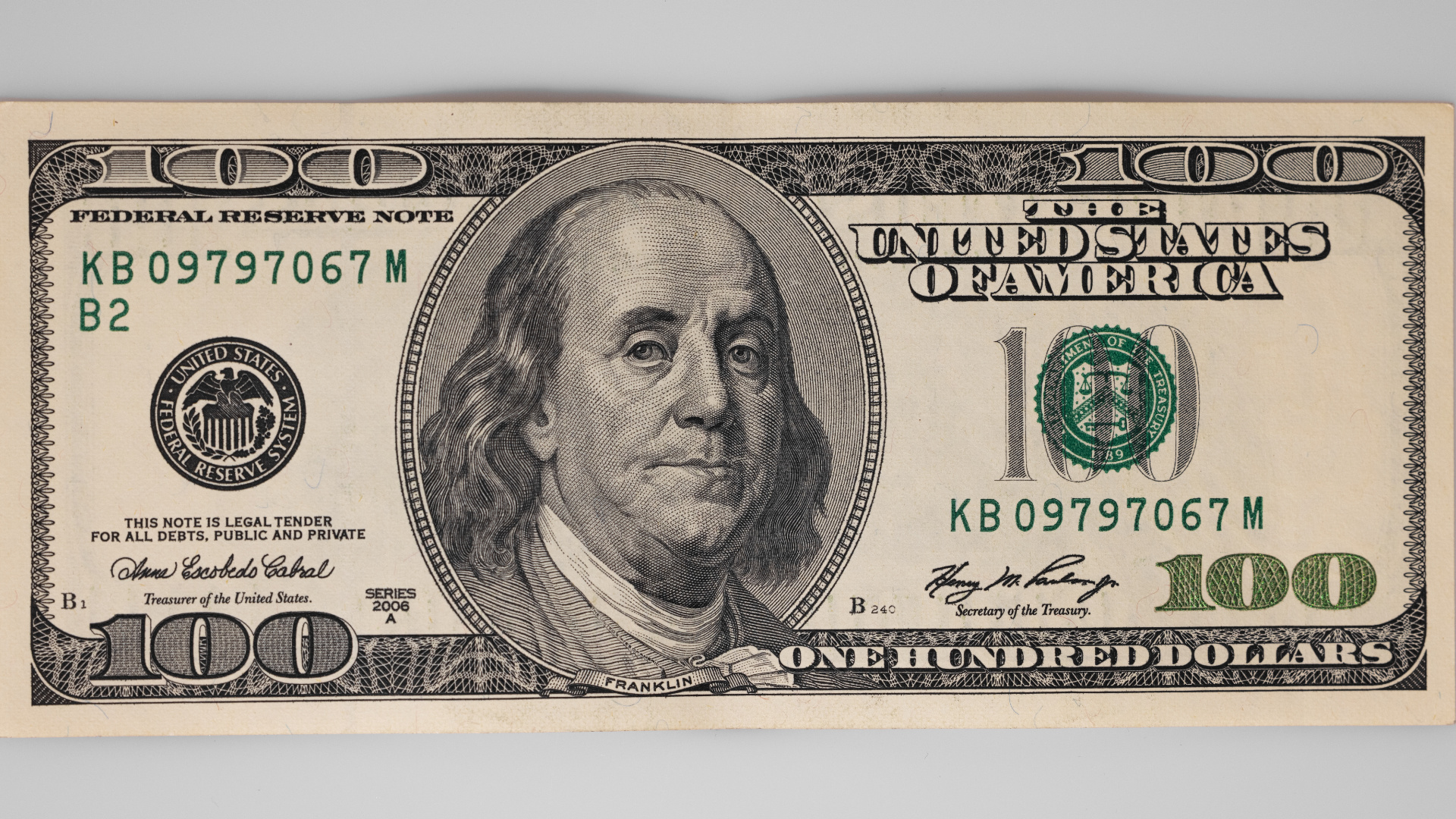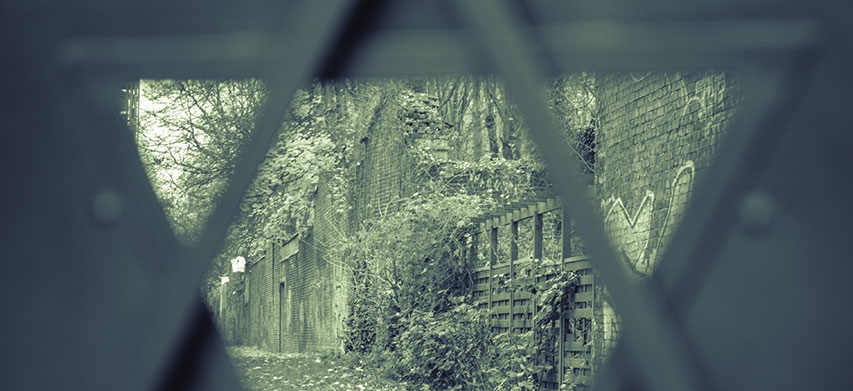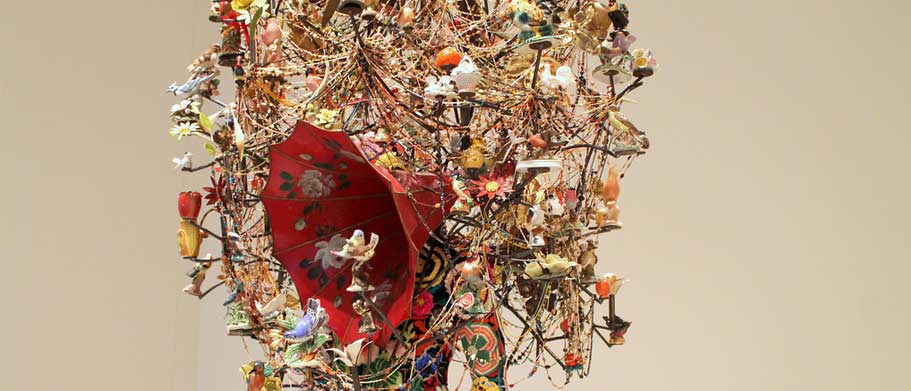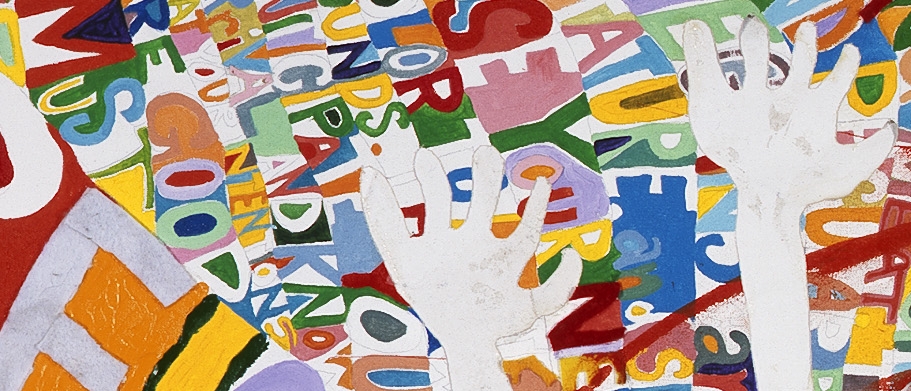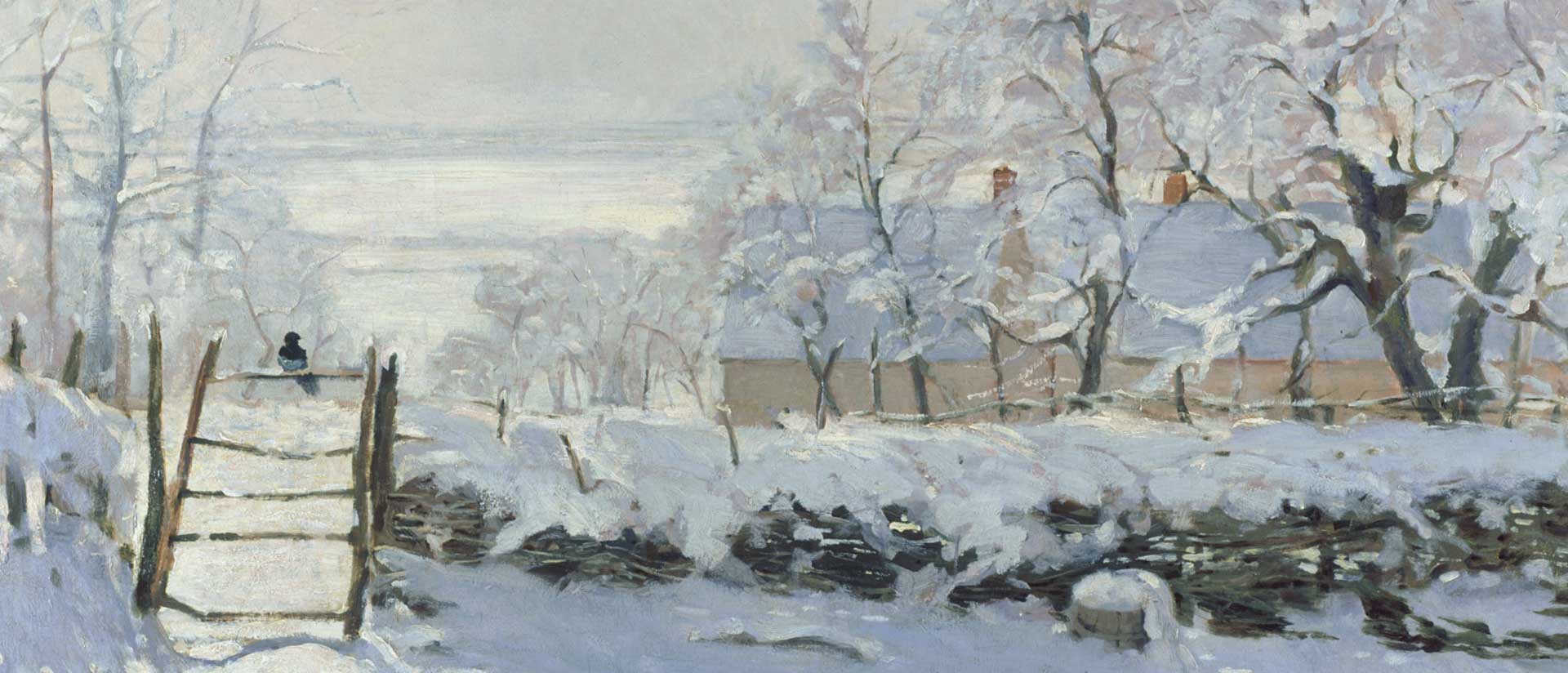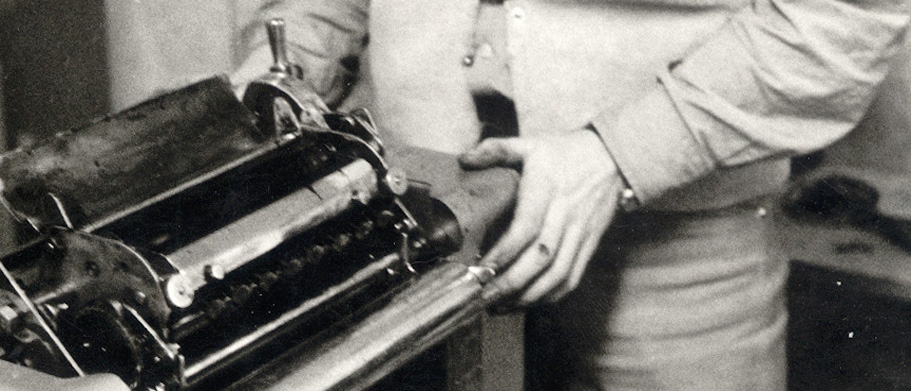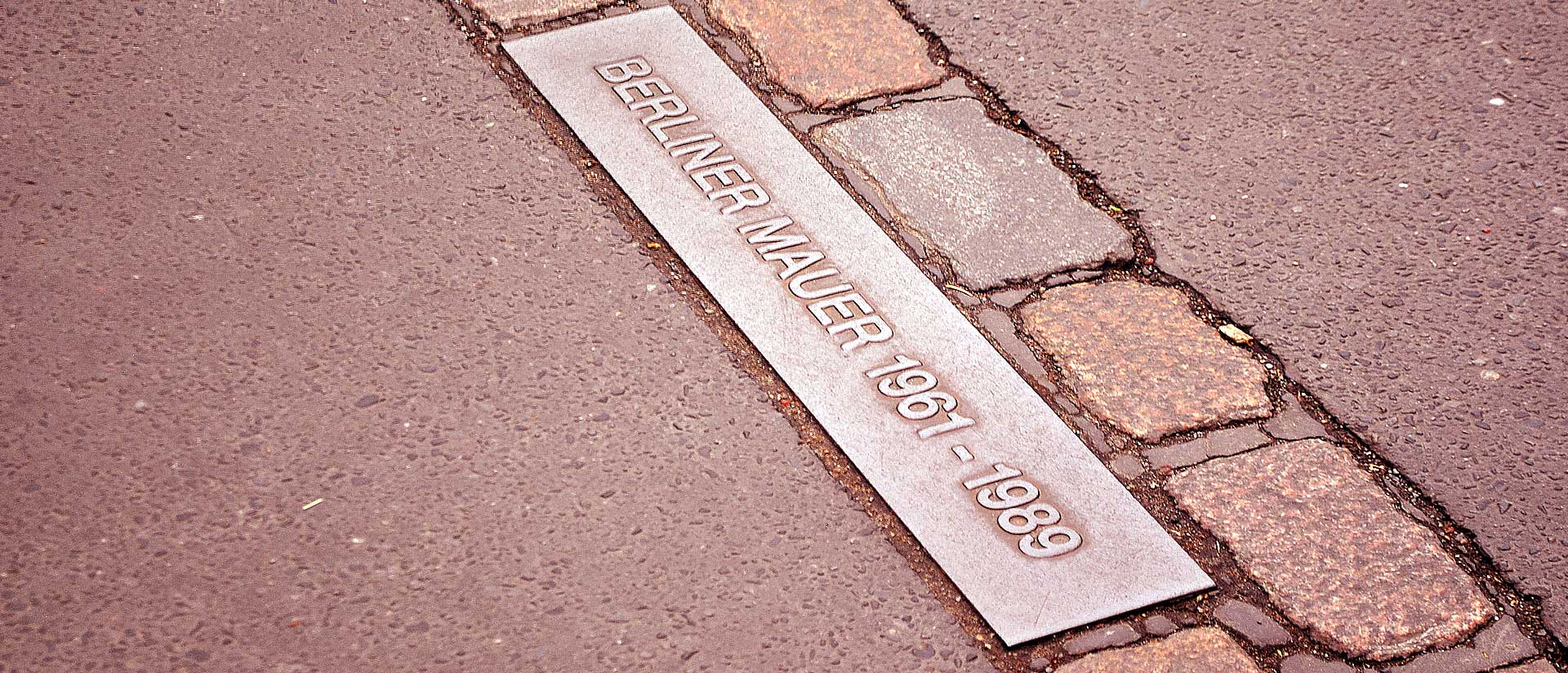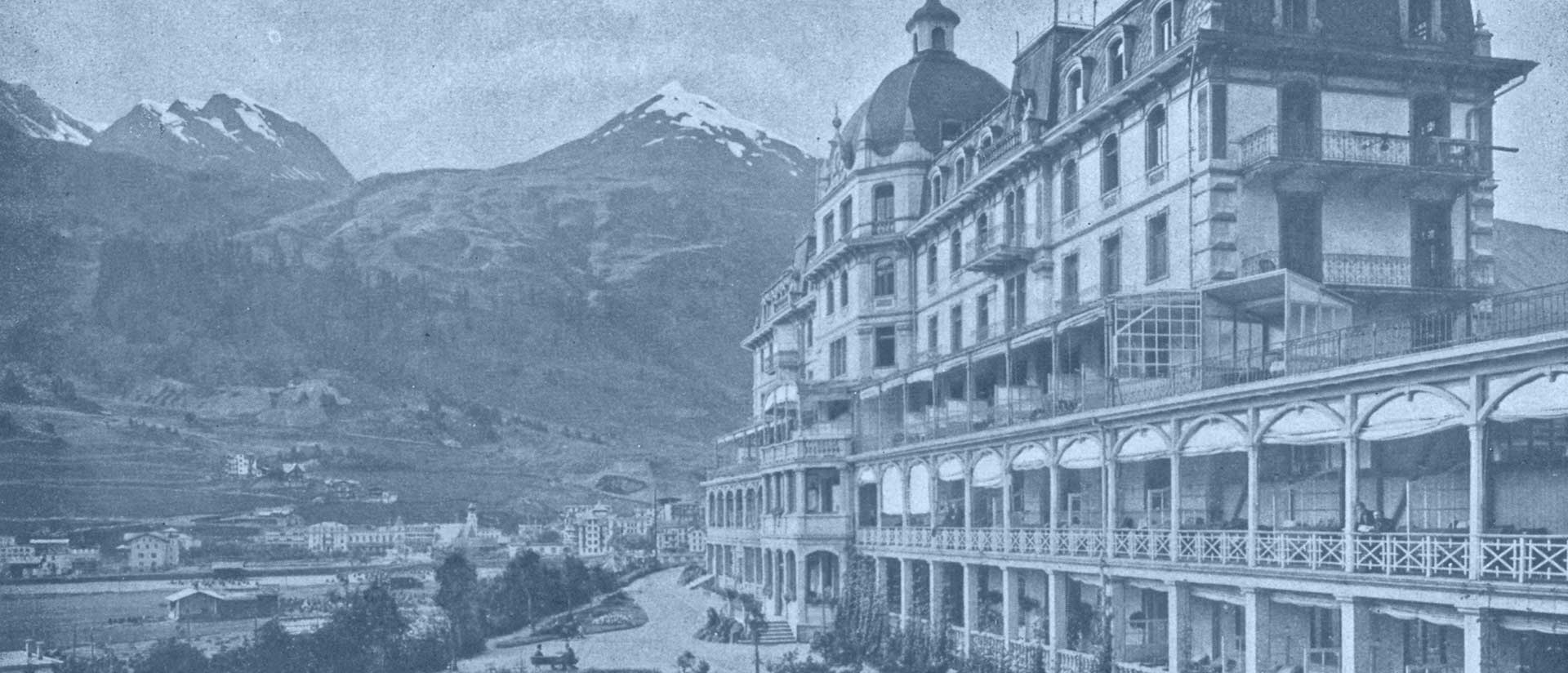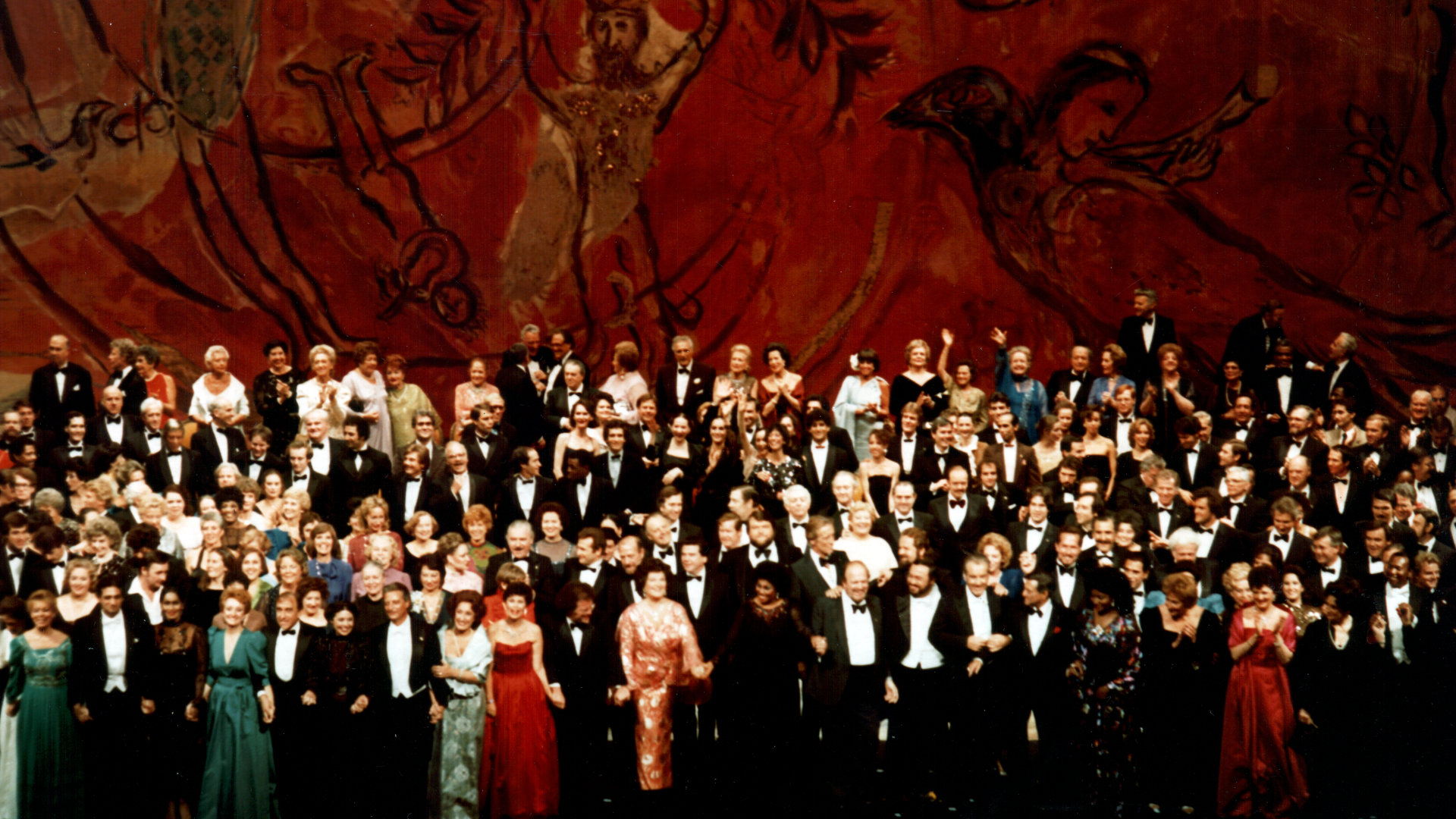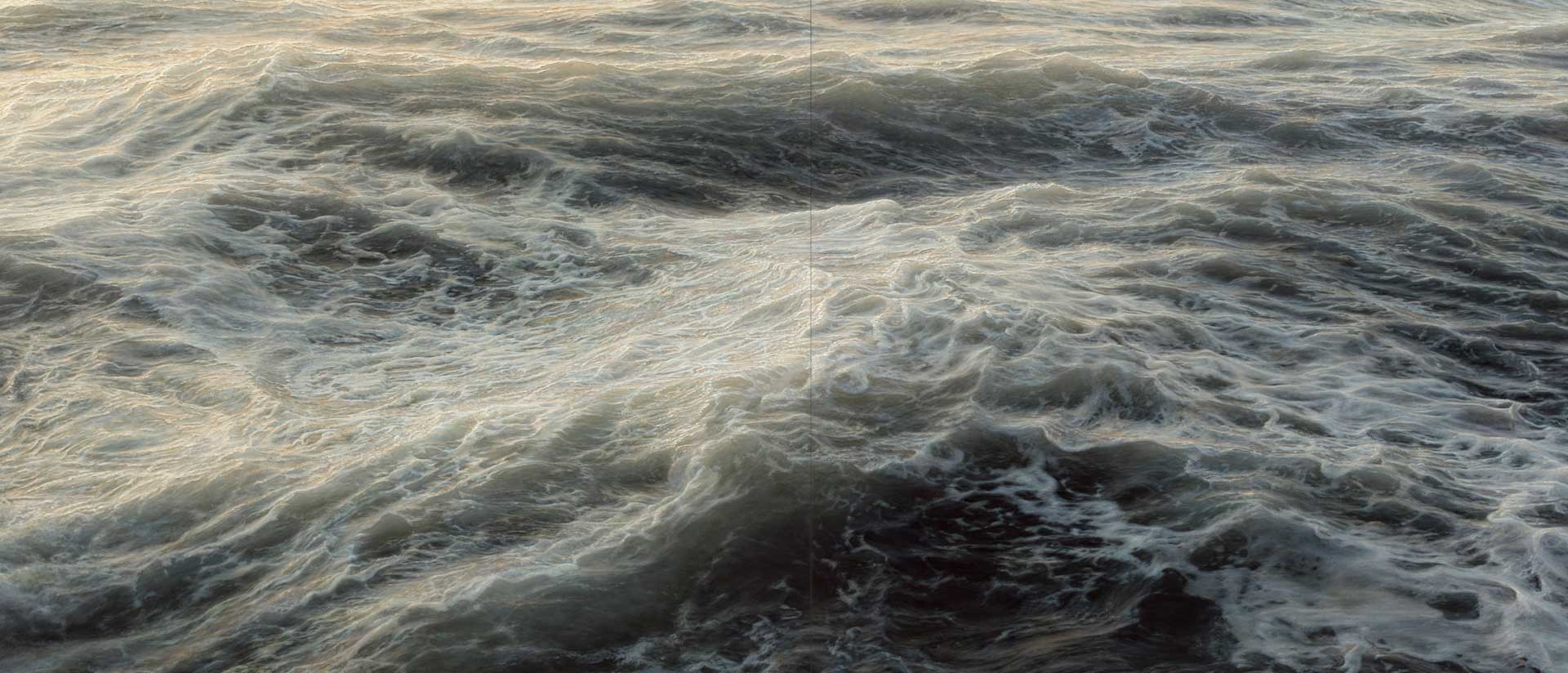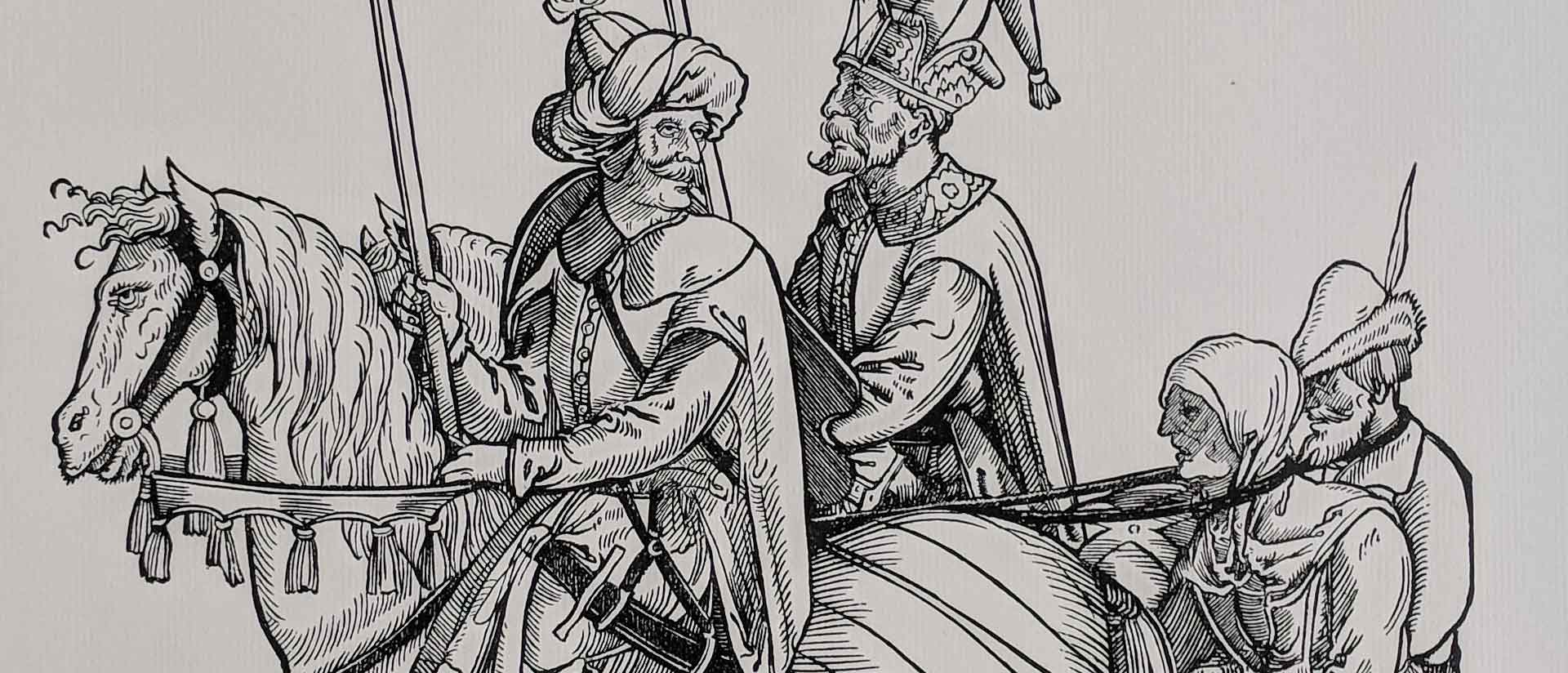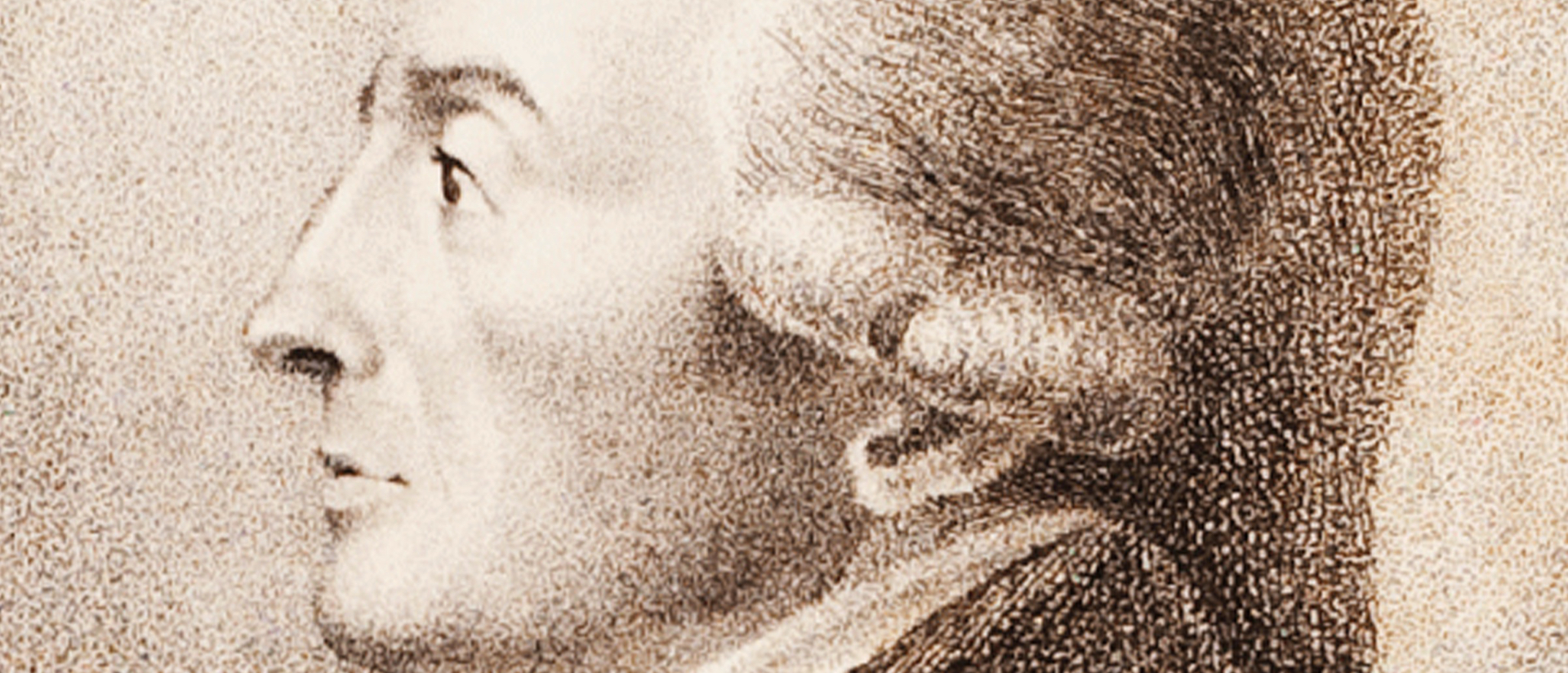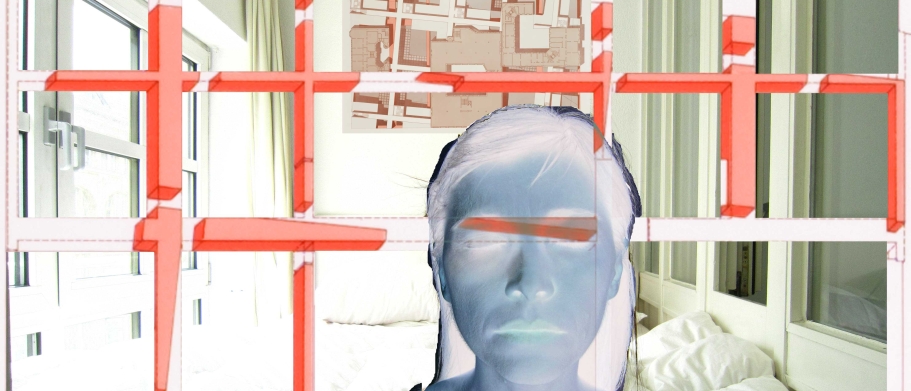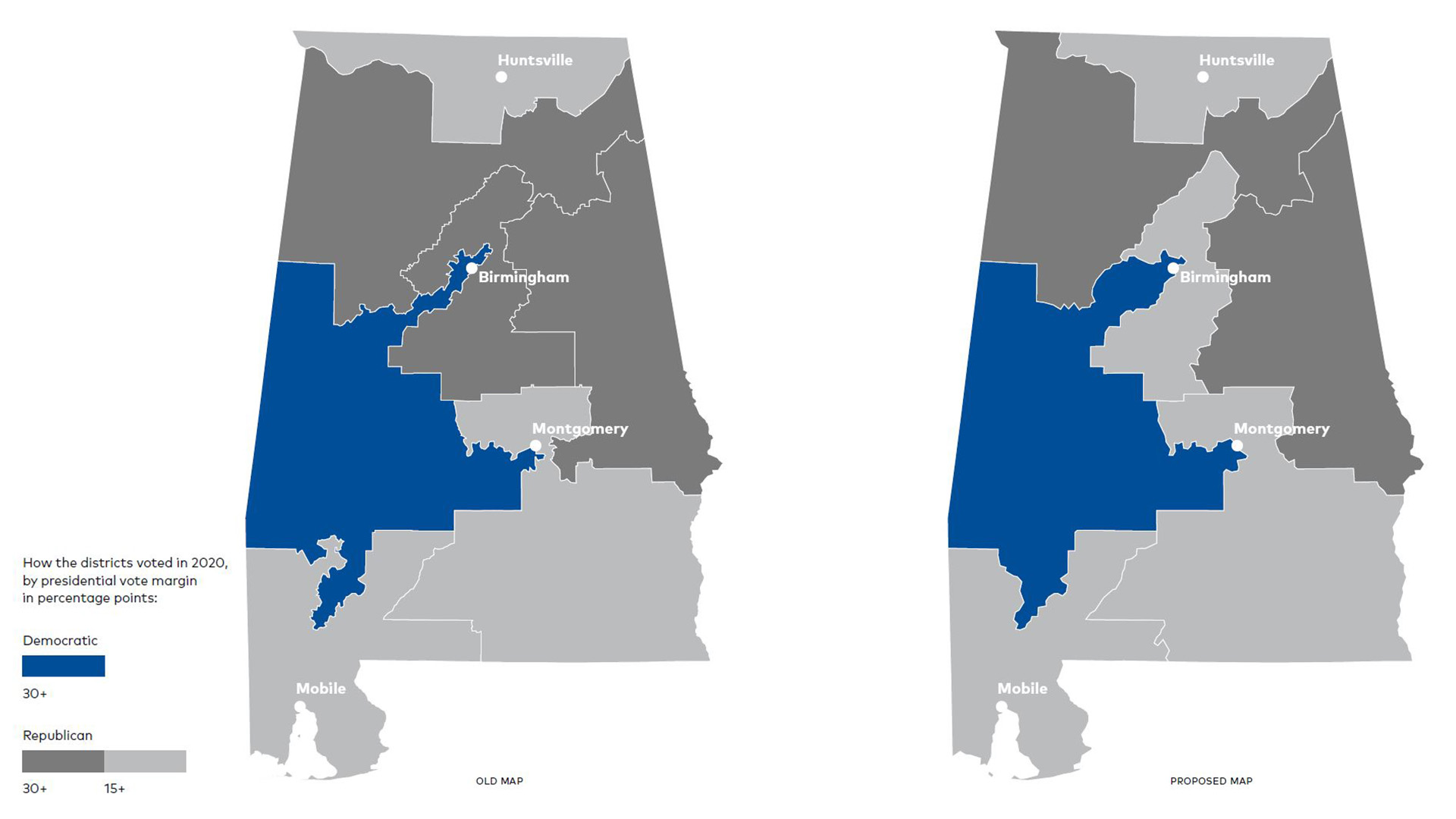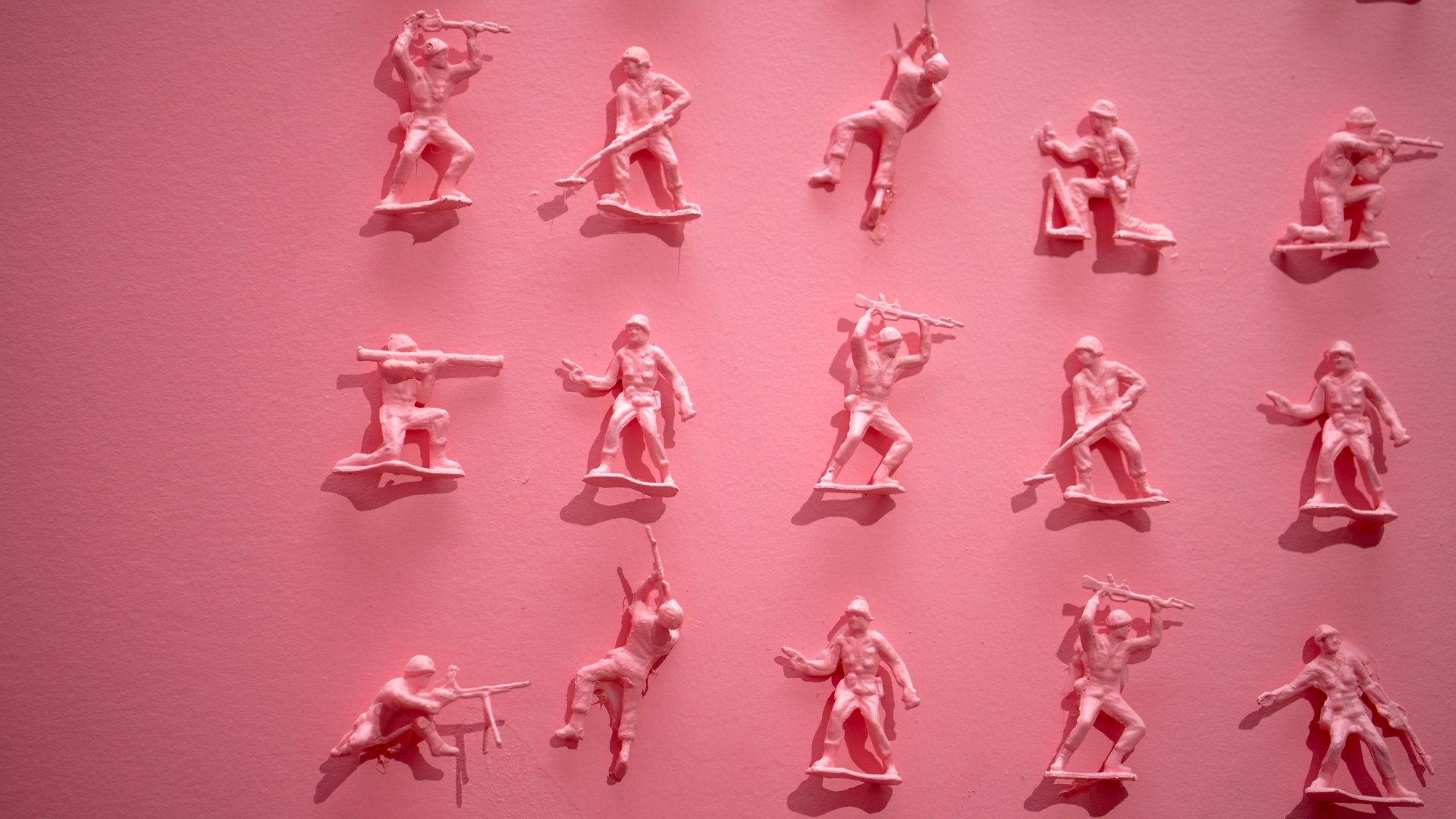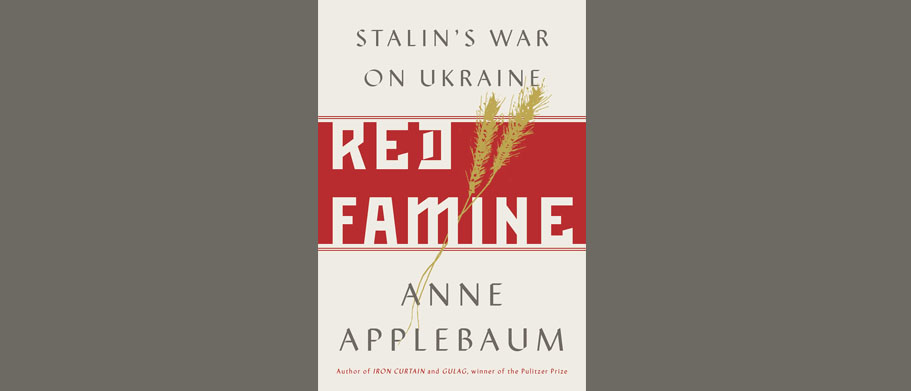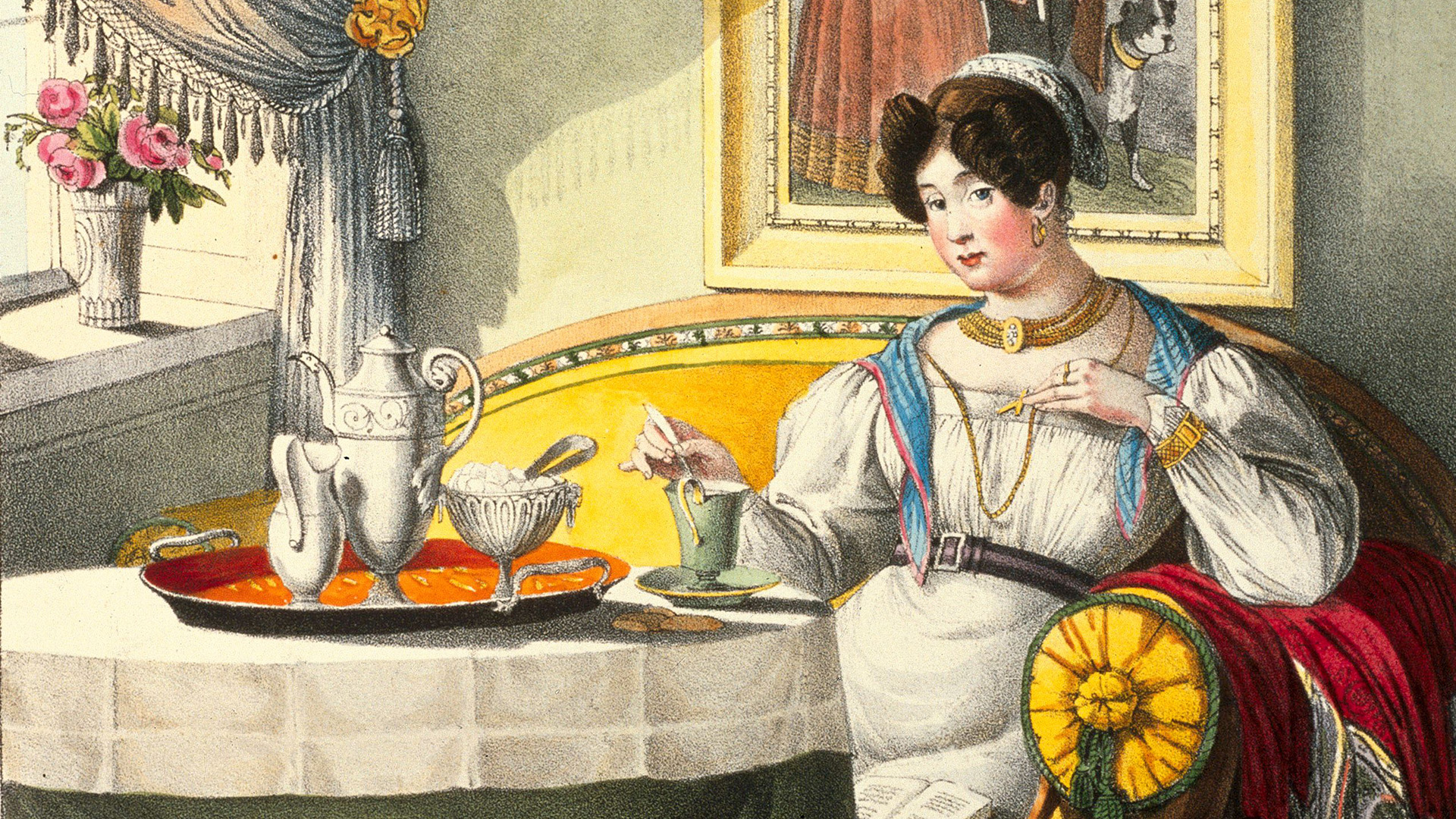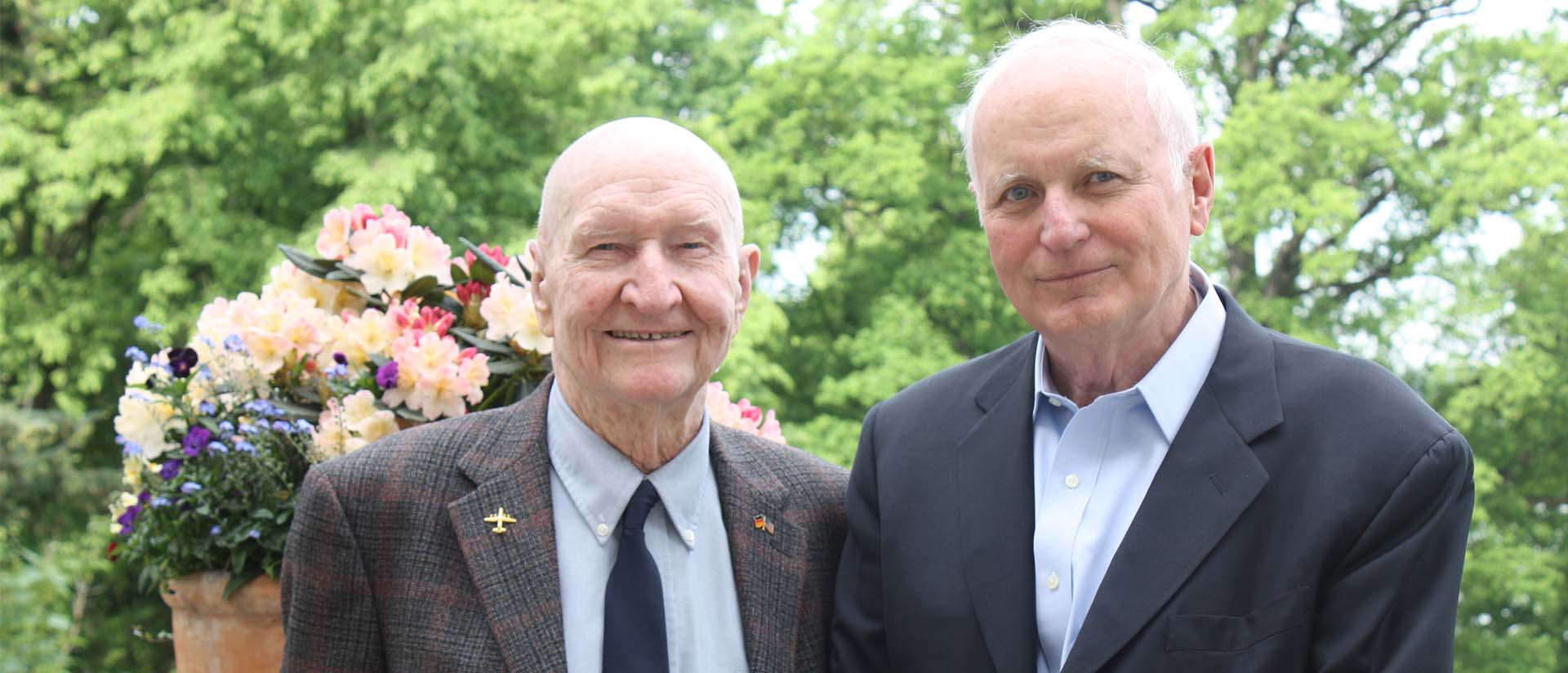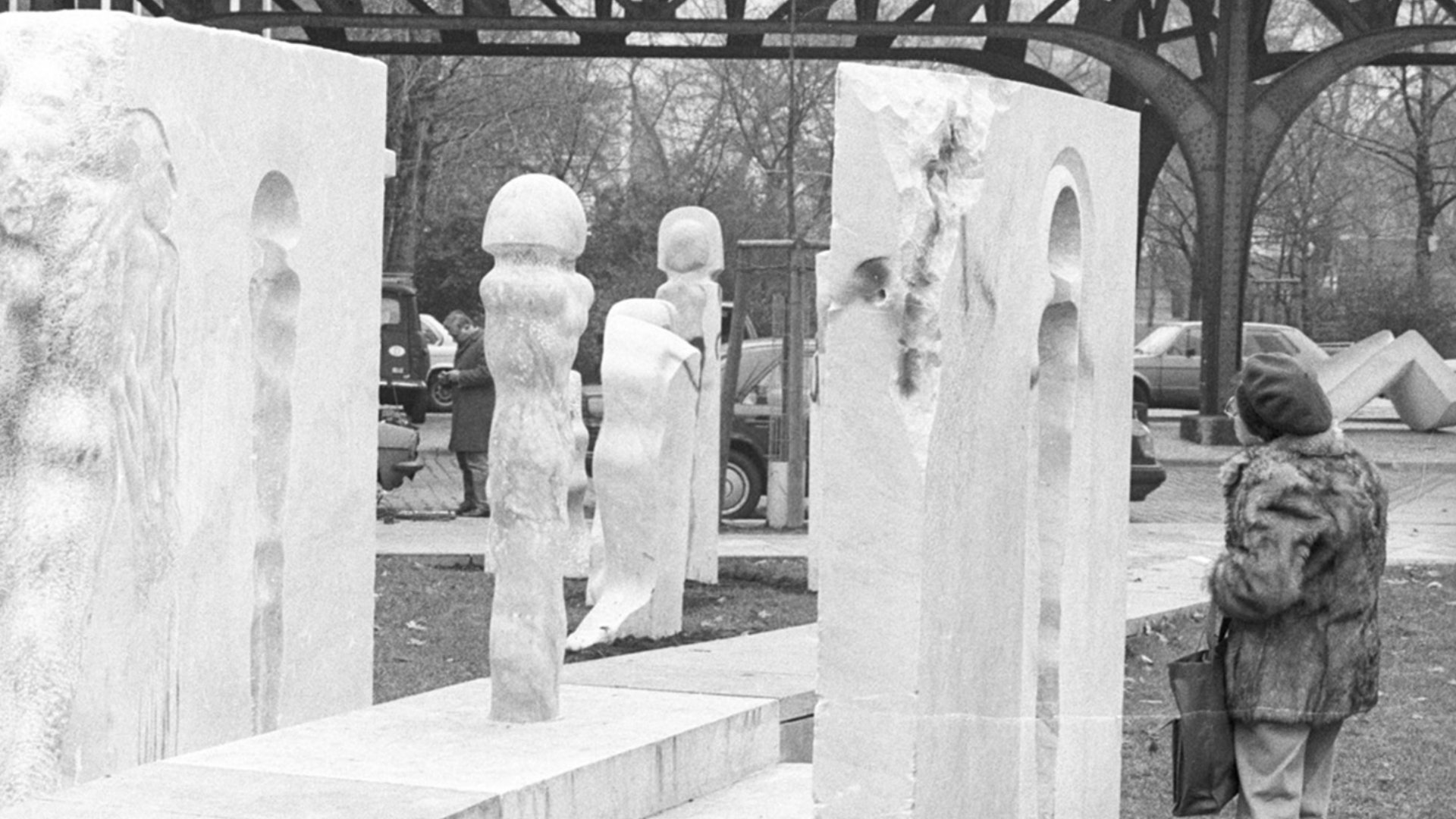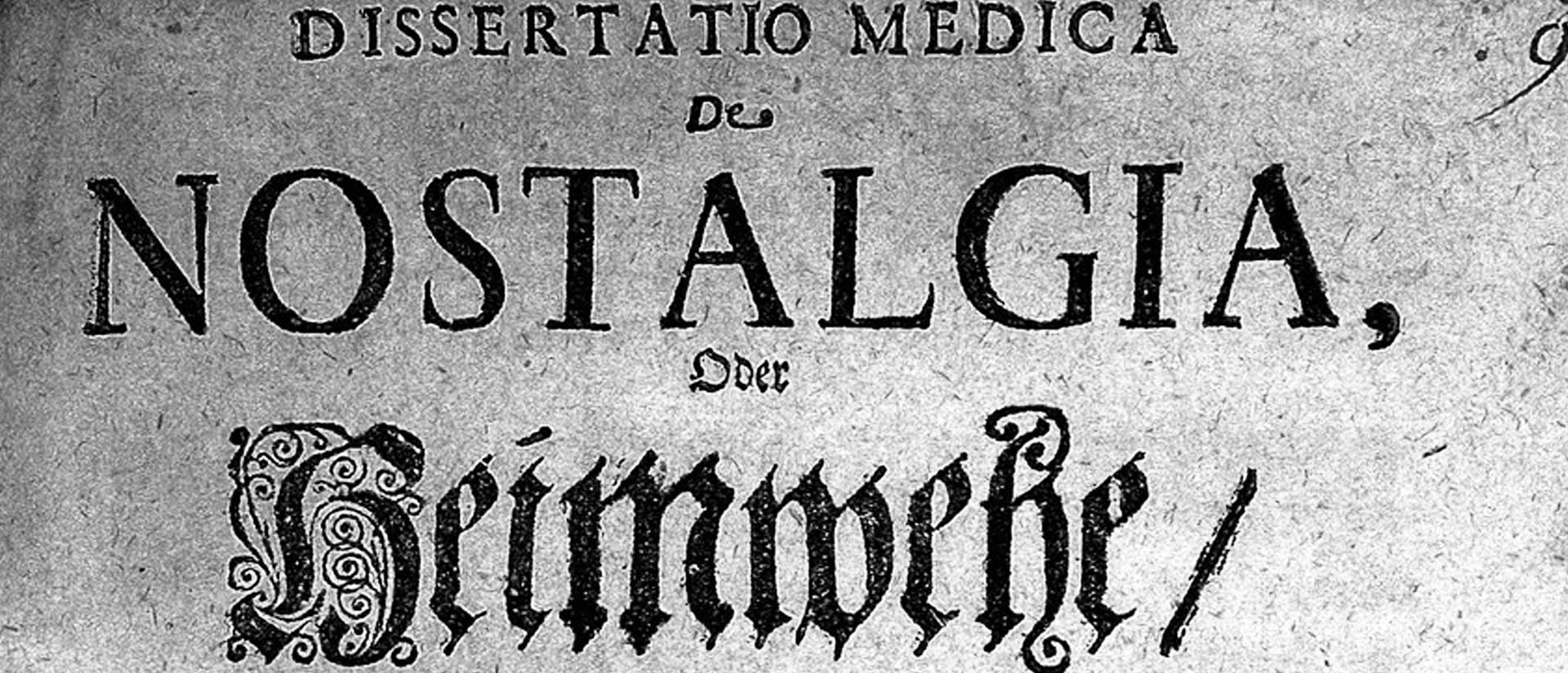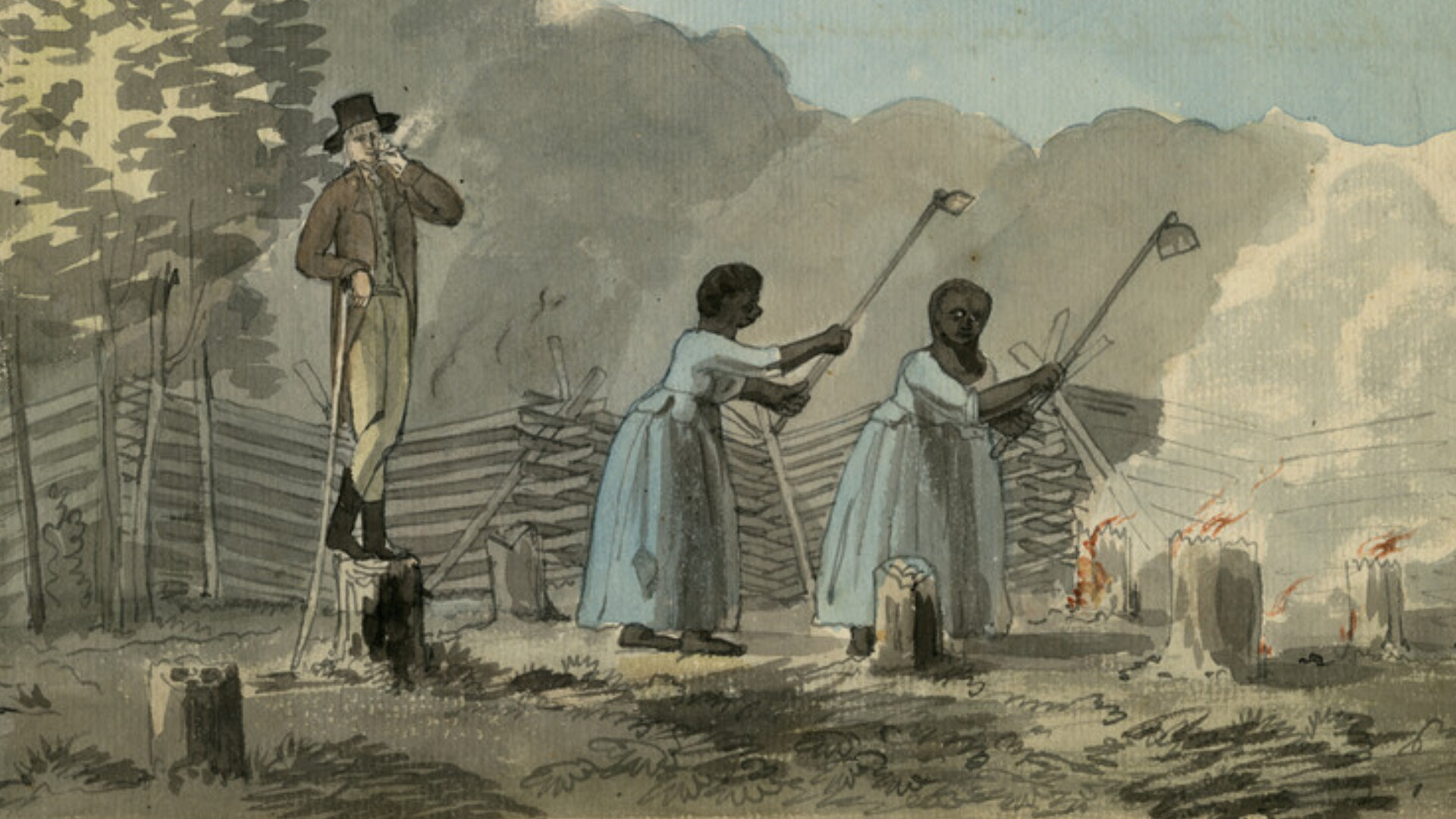
Notes on the Virginia Capitol
Nation and race in Jefferson’s America
By Mabel O. Wilson
While visiting Richmond, Virginia, in 1796, newly immigrated British architect Benjamin Henry Latrobe painted two watercolors of the state’s new capitol building. In translucent hues, one of the watercolors depicted the stately white temple in the distance, sitting nobly atop Shockoe Hill, overlooking the town’s sparsely populated pastoral landscape. One of the earliest examples of American civic architecture, the capitol building, which had been completed in 1788, was designed by statesman, architect, planter, and slave-owner Thomas Jefferson and modeled in part on the Maison Carrée, a first-century BCE Roman temple in Nimês, France.
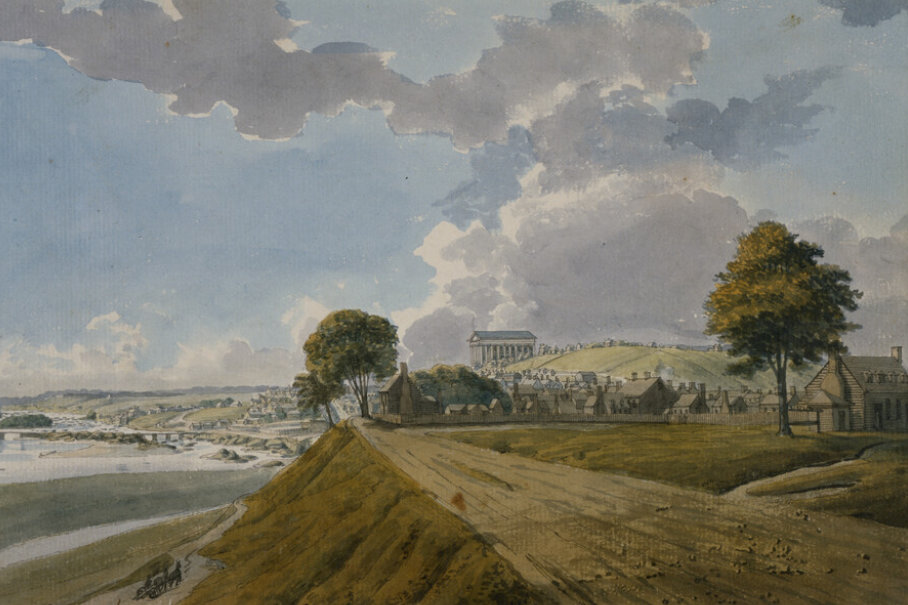
In 1776, twenty years before Latrobe’s visit, Virginia had drafted and ratified its state constitution, of which Jefferson had been a key author; the document established a separation of powers that would go on to become a model for the organization of the federal government. The new building Jefferson envisioned to house Virginia’s governmental functions needed both to symbolize and to enable the power of “the people” to govern and adjudicate the laws of the new state. The self-trained architect also intended the neoclassical state capitol to serve as a model for civic architecture throughout the 13 states, as well as in the yet-to-be-determined seat of the federal government.
It is critical that we understand how “the people” of Virginia—and by extension “the people” of the United States of America—were identified and defined during this period of revolutionary action and post-revolutionary planning. In other words, who were Virginians or American citizens, endowed with constitutional rights, and who were not? A survey of the population of the port town of Richmond reveals the racial contours of this division. The city’s white residents, who were America’s newly minted citizenry, staffed and served in its government seat; patronized its taverns, shops, stables, and inns; profited from its docks along the James River and from its warehouses trading in tobacco and slaves; and lived in the wood-framed houses shown in the foreground of Latrobe’s watercolor.
Who were Virginians or American citizens, endowed with constitutional rights, and who were not? A survey of the population of the port town of Richmond reveals the racial contours of this division.
Among the several thousand white Americans living in Virginia in the late eighteenth century labored an almost equal number of noncitizens—free and enslaved African men, women, and children. The enslaved served their masters and mistresses to produce the region’s great wealth. Chattel slavery—believed by some to be a necessary evil— buttressed America’s civilized values of freedom, liberty, and equality. Enslaved Black people, humans classified as property, also built several of the nation’s most important civic buildings: the Virginia State Capitol, the White House, and the US Capitol. Designed by white architects, these edifices stand as the Enlightenment’s monuments to the power of reason and the virtues of equality, justice, and freedom. There is, however, an inherent contradiction—some might argue a disavowal—in how the Founding Fathers constituted a new nation that ensured liberalism’s “unalienable rights” to “Life, Liberty and the pursuit of Happiness,” while continuing to violently enslave other human beings for personal gain.
The white-columned neoclassical buildings appeared to visitors as idyllic beacons of democratic values overlooking sublime nature unsullied by the presence of those spaces in which unsightly slaves toiled to make the land fertile and the lives of white citizens comfortable. With nationalism growing in the West in the closing decades of the eighteenth century, Europeans continued to conceptualize the racial paradigm of human difference that had emerged from centuries of contact with and colonial expansion into Asia, Africa, and the New World.
During the Revolutionary period and shortly thereafter, “race” had not yet been categorized in the hierarchical terms of biological variations and evolution as would happen under the disciplines of modern science in the mid-nineteenth century. Natural philosophers and historians of this period, among them Immanuel Kant, Johann Gottfried Herder, Georges-Louis Leclerc (Comte de Buffon), and Thomas Jefferson himself, debated the meaning of the human species’ observable physiognomic variations (outer character) and perceived mental distinctions, such as temperaments and humors (inner character). Their observations and experimentations sought to uncover the laws—climatic or geographic—that governed differentiation in the human species across the globe.
In Observations on the Feeling of the Beautiful and the Sublime (1764), for example, Kant scrutinized the “national character” to be observed in the Negro:
The Negroes of Africa have by nature no feeling that rises above the trifling. Mr. Hume challenges anyone to cite a single example in which a Negro has shown talents, and asserts that among the hundreds of thousands of blacks who are transported elsewhere from their countries, although many of them have even been set free, still not a single one was ever found who presented anything great in art or science or any other praiseworthy quality, even though among the whites some continually rise aloft from the lowest rabble, and through superior gifts earn respect in the world.
Kant and other such men of letters placed European “man” in a position of superiority above the other races, by virtue of the aesthetic perfection of white skin and the capacity to reason, evident in the ability to comprehend the law and to appreciate beauty. For theorist Sylvia Wynter, this overdetermined European mode of being human, “man,” evolved in two phases: The first period, from the fourteenth to the eighteenth century, charted the decline of belief in divine and magical causation and witnessed the rise of the physical sciences that sought to understand the natural forces that animated the world, replacing the belief that the biblical curse of Ham, for example, had colored Africans black. During the second period, from the eighteenth century onward, the biological sciences developed; these demonstrated that nature’s own laws were behind natural forces. It was through this rational framework that race came to be considered as biologically determined. This invented “man” was, for Wynter, “made possible only on the basis of the dynamics of a colonizer/colonized relation that the West was to discursively constitute and empirically institutionalize on the islands of the Caribbean and, later, on the mainland of the Americas.”
The resulting forms of racial patriarchy nominated white males as the bearers of power and the symbolic subjects of modernity, while simultaneously dismissing other epistemological frameworks as archaic and devaluing other ways of being human. Europe, as Wynter and others have written, invented race as an instrument of domination. As the West shifted from a Judeo-Christian cosmology of heavens and the earth to a humanist worldview, philosophers deployed universal reason to imagine a self-determined and self-conscious moral subject—political man—who perceived and conceived “the nature of things,” including his social relations. Natural rights became foundational for new social formations—nation states—whose governments, guided by historically derived ideas of democracy, ensured freedom for their citizens.
The resulting forms of racial patriarchy nominated white males as the bearers of power and the symbolic subjects of modernity, while simultaneously dismissing other epistemological frameworks as archaic and devaluing other ways of being human.
At the same time, Europeans also invented the category “Others of Europe,” to borrow Denise Ferreira da Silva’s term, to describe those who were not modern, not rational, not free, not white, and not citizens. These subhumans, often feminized as weak and submissive, labored in the colonies and dwelled in yet-to-be-charted territories. Europeans consigned nonwhite people, with their supposedly tenuous moral and physical character, to the bottom of the repurposed Great Chain of Being. Natural historians and scientists developed representations of time and space in the emerging discourses of history and science that placed nonwhite people in prehistory and in regions unexplored on colonial maps. The rendering of nonwhite people as primitive and uncivilized in turn rationalized the conquest of their territories, the expropriation of their land and labor, and the elimination of their lives by war or disease. The “Others of Europe’s” racial inferiority, particularly their lack of culture in white European eyes, dialectically elevated and affirmed the universal man and whiteness as the ideal representations of the human in the West’s own imagination.
It is important to keep in mind that from the fifteenth century onward, secular reason also had an impact on European “arts of building,” on building’s transformation from a medieval trade guild to the modern discipline of architecture. With the rise of academies and learned societies, architectural treatises circulated debates on the appropriate use of architecture, proportions of classical elements, and the ideal configuration of different building types. New techniques of geometry and cartography influenced modes of architectural representation. A growing interest in mechanics, documented at length in dictionaries and encyclopedias, advanced new construction methods that separated architecture from engineering. In other arenas, natural philosophers explored man’s capacity for aesthetic judgment to assess which ideal forms were visually pleasing. The taxonomic methods used by natural historians to discern speciation, in particular racial differences, were applied to the study of the historical transformation of buildings to determine character and organization. To begin to chart a history of architecture, scholars made comparative archaeological, ethnographic, and aesthetic evaluations of how far Europe’s architecture had advanced beyond the rest of the world’s ancient and primitive building practices.
These technical and aesthetic developments gave rise to the figure of the modern architect. At first self-taught elites like Jefferson, but eventually European apprentice-trained architects like Latrobe, were employed by the state and private citizens to design the government buildings, offices, banks, customhouses, storehouses, libraries, museums, prisons, great houses, and plantations that symbolized regimes of power and organized the territorial dynamic between metropole and colony. Jefferson’s designs for the Virginia State Capitol reveal the mutually constitutive relationship between race, reason, and architecture.
Born into the wealthy European planter class of colonial Virginia, Jefferson was a slave owner himself who also epitomized the consummate humanist polymath. Because his oeuvre encompasses the aesthetic and technical domain of architecture, the political realm of government, and the rational sphere of natural philosophy and history, his works offer an ideal lens through which to understand the intersections of the emerging discourses of architecture, nationalism, and racial difference as they coalesced in the late eighteenth century. Analyzing Jefferson’s architecture and his writings, together with correspondence from this period, broadens our understanding of the social, economic, cultural, and political context in which the first work of American civic architecture—the Virginia State Capitol—was conceived and realized.
In 1776, Jefferson proposed a bill to the Virginia House of Delegates to move its state capital from Williamsburg, the colonial seat since 1699, to Richmond, a fledgling settlement farther up the James River. Jefferson drew up the first designs for the Virginia State Capitol in 1776, and then revised them from 1779 to 1780. In Jefferson’s estimation, to adequately house Virginia’s growing white constituency and government, construction practices needed to evolve beyond the production of the crude, ugly wooden structures and awkwardly proportioned brick buildings that were found in Williamsburg. “Architecture,” he lamented, “seems to have shed its maledictions over this land.” Brick and stone were proper materials for building because of their longevity, he rationalized. However, Virginia lacked craftsmen and workmen trained to draw and execute correctly the classical orders of entablatures, pediments, and columns. This lack of skilled labor was perhaps an outcome of the fact that one segment of the construction workforce was enslaved. Literacy, especially the ability to write, was discouraged among the enslaved in order to maintain subjugation and suppress revolt.
This lack of skilled labor was perhaps an outcome of the fact that one segment of the construction workforce was enslaved.
All the components of the new republic—executive, legislative, judicial—were accounted for in Jefferson’s bill and in his initial drawings of the state capitol that placed each branch in its own building on Shockoe Hill. Jefferson possessed several key folios of Renaissance architect Andrea Palladio and other volumes on Greek and Roman antiquities. He had experimented with Palladian neoclassicism at Monticello, his plantation house under construction in the Piedmont, and in unbuilt designs for his alma mater, the College of William and Mary.
In 1784, Jefferson succeeded Benjamin Franklin as the minister plenipotentiary to France, a post he held for five years. During his diplomatic assignment in Paris, where he lived with his two daughters, along with several accompanying enslaved persons to tend to their needs—including a teenaged Sally Hemings, who would later sire children with him—Jefferson was charged with finally completing the plans for the Virginia capitol, once the land on Shockoe Hill had been claimed by eminent domain. Governor Patrick Henry wrote to Jefferson in the late summer of 1785 that a cornerstone had been laid and that foundations of brick were out of the ground, based on Jefferson’s earlier drawings. With construction commencing, Jefferson needed to act quickly to refine and complete his designs. To assist with the preparation of drawings and a model, he recruited French architect Charles-Louis Clérisseau, a skilled draftsman and archaeologist. Jefferson had reviewed drawings of the perfectly preserved Maison Carrée in books and greatly admired Clérisseau’s publication Antiquités de la France, Première Partie: Monumens de Nîmes (1778), which he eventually purchased from Clérisseau while in Paris. Clérisseau’s meticulous orthographic documentation suited Jefferson, who possessed not only the eye of an architect, but also the fastidious gaze of a naturalist.
Because the legislators desired to conduct all of the state’s business in one structure, Jefferson with Clérisseau revised the earlier plans and placed the General Court on the first floor, across from the state’s lower chamber, the House of Delegates. At the center of the elegantly proportioned two-story atrium that connected the two chambers with other functions in the building, Virginians planned to erect a statue to General George Washington. The second floor housed the senate chambers and auxiliary spaces for clerks. The new design took advantage of the basilica form, so that the protocols of assembly, deliberation, and adjudication, adapted from the colonial government, would operate smoothly in the space.
The new design took advantage of the basilica form, so that the protocols of assembly, deliberation, and adjudication, adapted from the colonial government, would operate smoothly in the space.
In a letter to James Madison, Jefferson expressed his desire that Virginia’s new capitol building would become a model of architecture worth emulating throughout the new nation: “How is a taste in this beautiful art to be formed in our countrymen, unless we avail ourselves of every occasion when public buildings are to be erected, of presenting to them models for their study and imitation?” Jefferson apprised his friend that for many people the Maison Carrée was “one of the most beautiful, if not the most beautiful and precious morsel of architecture left us by antiquity.” The monuments of antiquity offered Americans perfectly preserved examples of Greco-Roman classicism, an architecture emblematic of truth, justice, and democracy, one that, for Jefferson, had not been corrupted by capricious flourishes of the late baroque’s rococo period that suited the tastes of the French aristocracy.
Jefferson commissioned model maker Jean-Pierre Fouquet to complete a plaster maquette of the design. In June 1786, he shipped the model along with Clérisseau’s drawings to Richmond. The rationale for replicating historical buildings held in high regard was that the design for such buildings was “very simple, but it is noble beyond expression, and would have done honour to our country as presenting to travellers a morsel of taste in our infancy promising much for our maturer age.” Jefferson hoped that the new capitol building would be a transformative exercise that would seed a new culture and society in the New World, yielding a ripe American civilization. His proposed designs for the Virginia State Capitol would offer an invaluable public primer on how architecture could represent the virtues of durability, utility, and beauty.
One challenge faced by Virginians—and the new union of 13 states—was how to cultivate the character of its new political subjects, “the people.” In eighteenth-century Europe and its colonies, refined taste in art, dress, architecture, and food (fueled by the growing appetite for sugar, coffee, and tobacco) became a marker of elevated intellectual and economic status. But this “culture of taste,” writes Princeton literary scholar Simon Gikandi, also harbored “repressive tendencies—namely, the attempt to use culture to conceal the intimate connection between modern subjectivity and the political economy of slavery.” This interdependence between the formation of a new white American culture, one that included the arts of building, and the enslavement of African peoples, justified by their presumed innate mental and physical inferiority, can be found in Notes on the State of Virginia, which Jefferson wrote in the same period in which he conceived the designs for Virginia’s capitol building.
Notes on the State of Virginia originated as a report Jefferson prepared in response to 23 queries sent to him in 1780 by a French diplomat, François Barbé-Marbois, who had created the survey to gain a better understanding of the geographic and historic character of the newly formed United States. Even though he sought to sever ties with what he believed to be a calcifying European aristocratic culture, Jefferson nonetheless preserved its aesthetic values as a visible register of white American culture. For Jefferson, Negroes, because of their naturally inferior faculties, could not be incorporated into the new nation state as citizens. In his response to Query 14, “The Administration of Justice and the Description of the Laws,” Jefferson sought a political solution to the problem of what to do with the Negro population living in Virginia, the majority of which was enslaved. On several occasions in state legislation and in early drafts of the Declaration of Independence, Jefferson had proposed language that terminated the importation of slaves into Virginia and the United States. (During his presidency, he would succeed, in 1808, in abolishing the international slave trade, but not its lucrative domestic market.)
Along with political concerns, Jefferson held “physical and moral objections” to Negroes based on a lifetime of observations of what he considered to be their comportment and character. Because universal reason relied upon experimentation and observation for the validation of truth, Jefferson’s conceptualization of the racial paradigm of human difference found one promising register in skin color. He rationalized that what counted as beautiful could be applied to the breeding of animals and therefore also to the human species—where variations in physiognomy, hair texture, and skin color were visible. Out of all these markers, skin color was the most obvious indicator of racial difference.
The origins of the skin’s coloration for Jefferson, however, could not be discerned by dissection of the epidermal layers or a chemical analysis of blood or bile. He determined skin color then as “fixed in nature,” and therefore of divine causation. The aesthetics of blackness were part of a rationalization of the variations in the human species that divided peoples living on the continents of Europe, Asia, Africa, and the Americas and affirmed the superiority of Europeans and their whiteness. Under Jefferson’s probing gaze, the features of the Black body were seen as less beautiful in comparison to the symmetry and flowing hair of white physiognomy. The overall lack of beauty in blackness visually and viscerally appalled Jefferson. He verified this by suggesting that even Native Americans found whites preferable, just as “the preference of the Oranootan [sic] [is] for the black women [sic] over those of his own species.” To posit Black women as subhuman, closer to primates, was based on a theory of polygenesis in natural history, which maintained that each race was a different species.
Jefferson determined skin color then as “fixed in nature,” and therefore of divine causation.
Blackness signified the Negro’s sub-humanity and validated her ruthless exploitation. The Negroes’ supposed inability to appreciate beauty, except in the most sensual manner, or to create works of true aesthetic value, except out of mimicry, also provided Jefferson with additional evidence of their natural mental inferiority. In Query 14, he surmised that in their ability to remember, Blacks were equal to whites, but in their ability to reason and to comprehend mathematics and sciences, they were certainly inferior. “In their imagination,” he wrote, Blacks were “dull, tasteless, and anomalous.”
Did the Negro, whether enslaved or freed, have a place in America? Jefferson put forward an emancipation scheme in his response to Query 14. He proposed that enslaved children “should continue with their parents to a certain age, then be brought up, at the public expence [sic], to tillage, arts or sciences, according to their geniusses [sic].” Once adults, women age 18 and men age 23 should be colonized to African, Caribbean, or western US territories and supported until they grew in strength. To replace the now-absent labor Jefferson proposed to send “vessels at the same time to other parts of the world for an equal number of white inhabitants.”
Pragmatically, Jefferson believed that Virginia’s history of chattel slavery would prevent Black and white races from living together peacefully in the same place, citing those “deep rooted prejudices entertained by whites; ten thousand recollections, by the Blacks, of the injuries they sustained.” Emancipation and citizenship for freed Blacks could only result in “convulsions which will probably never end but in the extermination of one or the other race.” American civilization, therefore, could not thrive with a free Black population. The undesirability of Blackness, the “unfortunate difference of color, and perhaps faculty, is a powerful obstacle to emancipation of their people,” argued Jefferson. Once enslaved Blacks were freed, Jefferson required them to be “removed beyond the reach of mixture.” Not only did revenge by Blacks pose a threat to the new nation in Jefferson’s eyes; mixing with them biologically through miscegenation could have unforeseen consequences of physiognomic and cultural degeneration.
In the end, Black bodies and Blackness for Jefferson and for others of his era proved an impenetrable threshold to reason. They were distasteful. Wielding the tools of enlightenment, Jefferson rationalized the Negro belonged at the back end of the social and political forces that would advance American civilization, in the same manner he designed their spaces of interminable servitude to occur below ground. While all men were born equal, as natural-rights proponents advocated, to Jefferson, the Negro possessed neither the aptitude to reason nor faculties to appreciate beauty or liberty. “The people” did not include Negroes. The prospect of a free Black American was both unreasonable and unimaginable to the sage of Monticello.
This essay appears in the Berlin Journal 37 (2023-24) and is adapted from “Notes on the Virginia Capitol: Nation, Race, and Slavery in Jefferson’s America,” by Mabel O. Wilson, from Race and Modern Architecture: A Critical History from the Enlightenment to the Present, edited by Irene Cheng, Charles Davis, and Mabel O. Wilson c 2020. Reprinted by permission of the University of Pittsburgh Press.
Images: Benjamin Henry Latrobe, An Overseer Doing His Duty near Fredericksburg, Virginia and View of the City of Richmond (both 1798), watercolor on paper, 10 × 7 inches. Courtesy Maryland Center for History and Culture

